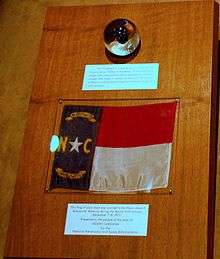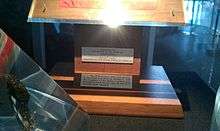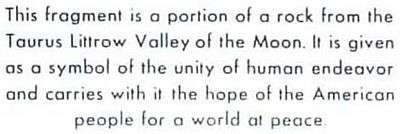North Carolina lunar sample displays
The North Carolina lunar sample displays are part of two commemorative plaques consisting of small fragments of Moon specimen brought back with the Apollo 11 and Apollo 17 lunar missions and given in the 1970s to the people of the state of North Carolina by United States President Richard Nixon as goodwill gifts.[1][2]

Description
Apollo 11

The North Carolina Apollo 11 lunar sample display commemorative podium-style plaque consists of four "Moon rock" rice-sized particle specimens that were collected by Apollo 11 astronauts Neil Armstrong and Buzz Aldrin in 1969 and a small North Carolina state flag that was taken to the Moon and back on Apollo 11.[1]
The four "Moon rocks" weigh about 0.05 grams total. They are encased in a clear plastic button the size of a coin which is mounted to a wooden plaque approximately one foot square on a small podium pedestal display. The small podium plaque display also has mounted on it a small North Carolina state flag that had been taken to the Moon and back, which lies directly below the "goodwill Moon rocks". The small podium plaque display was given to the people of the state of North Carolina as a gift by President Richard Nixon. Similar lunar sample displays were also distributed to all the other states of the United States and all the countries (at the time) of the world.[1]
The sample display is in the collection of the North Carolina Museum of History in Raleigh. It is not on public exhibition.[3]
Apollo 15
A 3.9 billion year old 3.2 ounces (91 g) sample collected by David Scott on August 1, 1971 is on display near a full-size mockup of the Lunar Module in the Museum of Life and Science in Durham. The sample is encased in pyramid shaped lucite.[4]
Apollo 17

The North Carolina Apollo 17 lunar sample display commemorative style plaque, measuring 10 by 14 inches, consists of one "Moon rock" particle specimen that was cut from lunar basalt 70017 and a North Carolina state flag. The basalt 70017 was collected by Apollo 17 astronaut Harrison Schmitt on the Moon in 1972. Once lunar basalt 70017 was brought back to Earth from the Moon, the basalt Moon rock was cut up into small fragments of approximately 1 gram. The specimen was encased in a plastic ball and mounted on the wooden plaque along with the Missouri state flag which had been taken to the Moon and back by the crew of Apollo 17. The plaque was then distributed in 1973 by President Richard Nixon to the state of North Carolina as he did that year to the other 49 states (the same as for the Apollo 11 plaque gifts). This was done as a goodwill gesture to promote peace and harmony.[2]
History
The North Carolina Apollo 17 "goodwill Moon rocks" plaque display that was given to the state of North Carolina in 1973 was lost for decades and eventually found by accident in a drawer at the North Carolina Department of Commerce. The Department had stored the Apollo 17 North Carolina "goodwill Moon rocks" display in unknown locations for some 30 years, from 1973 to 2003. In 2003 a new employee came across it in a desk drawer in his new office. The clear plastic ball with the 1 gram goodwill Moon rock encased in it was detached from the plaque display. The new employee was a colleague of Christopher Brown, professor at North Carolina State University, and asked permission to lend the North Carolina Apollo 17 plaque display and "Moon rock" to Brown, who is head of the University's Research Development Department and director of the North Carolina Space Grant. Upon receiving the materials on loan, Brown showed the "goodwill Moon rocks" display to hundreds of students from 2003 to 2010. In 2010 Brown presented both the plaque and "goodwill Moon rock" to the North Carolina Museum of Natural Sciences for public exhibition in the museum's new wing, where the North Carolina Apollo 11 lunar sample plaque display was already on display.[5][6][7]
References
- Pearlman, Robert (1999–2012). "Where today are the Apollo 11 goodwill lunar sample displays?". collectspace.com. Retrieved November 2, 2012.
- Pearlman, Robert (1999–2012). "Where today are the Apollo 17 goodwill lunar sample displays". collectspace.com. Retrieved November 2, 2012.
- North Carolina Museum of History
- "Blast Off!". Durham Magazine. Retrieved October 18, 2013.
- Price, Jay (July 28, 2010). "North Carolina's Moon rock to shine again in state museum". News & Observer. Raleigh, North Carolina: McClatchey. Retrieved November 3, 2012.
- "Earth magazine". March 2011: 49. Cite journal requires
|journal=(help) - Price, Jay (July 28, 2010). "State's elusive moon rock soon to become a big star". News & Observer. Raleigh, North Carolina: McClatchey. Retrieved November 3, 2012.
External links
| Wikimedia Commons has media related to North Carolina lunar sample displays. |

